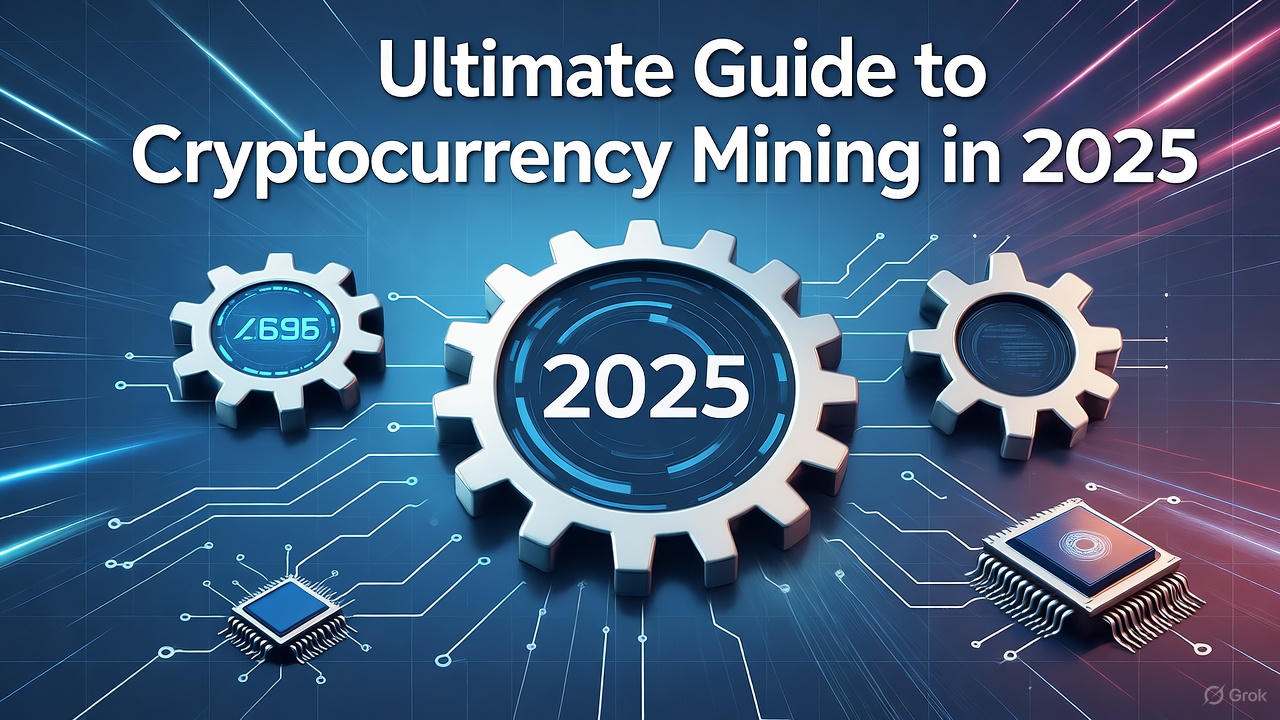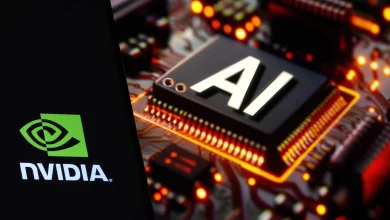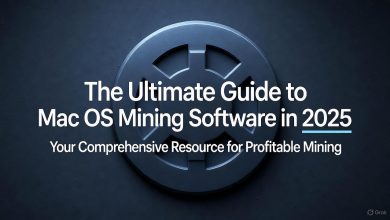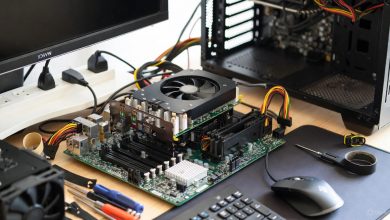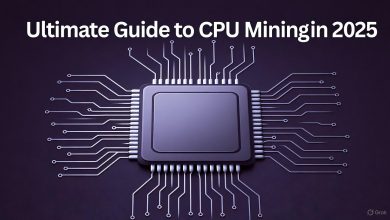Whether you’re a beginner eyeing passive income or an enthusiast optimizing your setup, we’ll cover everything from software reviews to profitability strategies. Let’s dive in and turn your hardware into a mining powerhouse.
A typical GPU mining rig setup for beginners
Bitcoin Mining Software for PC
In 2025, the best Bitcoin mining software for PCs includes CGMiner, BFGMiner, MultiMiner, Awesome Miner, and EasyMiner, which support both Windows and Mac with versatile features for ASIC and GPU setups. NiceHash stands out for its user-friendly interface and auto-switching to the most profitable coins, making it ideal for beginners. Kryptex Miner is another top pick, offering seamless integration with Windows for quick payouts in Bitcoin or fiat.
For installation, download from official sites like nicehash.com, configure your wallet, and join a mining pool like F2Pool or Slush Pool. Performance tips: Monitor hash rates (aim for 50-100 TH/s on mid-range ASICs) and electricity costs—use tools like WhatToMine for profitability estimates. Compared to others, CGMiner excels in customization but requires command-line knowledge, while EasyMiner provides a GUI for hassle-free operation.
How to Start Bitcoin Mining
Starting Bitcoin mining in 2025 as a beginner? Follow this step-by-step guide: First, assess hardware—ASIC miners like the Bitmain Antminer S21 (200 TH/s) are essential for profitability, costing $2,000-$5,000. You’ll need a stable power supply (at least 1,600W PSU), cooling fans, and a quiet space to manage noise and heat.
Step 1: Choose a mining pool (e.g., Binance Pool) to combine hash power and earn steady rewards. Step 2: Install software like CGMiner or NiceHash. Step 3: Set up a Bitcoin wallet (e.g., Ledger or Electrum). Step 4: Configure and start mining—monitor via apps for overclocking and efficiency.
Profitability calculations: With electricity at $0.10/kWh, a S21 could net $10-20/day post-halving, but factor in the 3.125 BTC block reward. Use calculators from CoinLedger for real-time estimates. Home mining is viable but scales better with multiple rigs.
shutterstock.comIllustration of mining Bitcoin on a laptop
Mining Bitcoin on Laptop
Is mining Bitcoin on a laptop feasible in 2025? Technically yes, but not profitable—laptops lack the ASIC power needed, with GPUs like RTX 40-series offering only 0.5-1 MH/s, far below competitive levels. Heat management is crucial; use cooling pads and limit sessions to avoid throttling or damage.
Software options: NiceHash QuickMiner or CryptoTab Browser for easy setup, but expect pennies daily. Alternatives: Switch to CPU/GPU-friendly coins like Monero, or opt for cloud mining to bypass hardware risks. Overall, laptops are better for testing than serious mining—consider desktops for better ROI.
Easiest Crypto to Mine
For beginners in 2025, the easiest cryptos to mine include Monero (XMR) with its RandomX algorithm for CPUs, Ravencoin (RVN) via KAWPOW for GPUs, and Vertcoin (VTC) using Verthash. These are ASIC-resistant, lowering entry barriers—start with a standard PC.
Tutorials: For Monero, use XMRig software; join pools like MineXMR. Ravencoin mining with T-Rex miner yields ~10-20 RVN/day on a RTX 3060. Low-barrier tips: Free trials on NiceHash, and calculate rewards using Whattomine.com. Other easy picks: Zcash (ZEC) and Ethereum Classic (ETC).
awesomeminer.comInterface of popular GPU mining software like Awesome Miner
Best Crypto Mining Software for Beginners
Beginners should start with user-friendly software like EasyMiner, which offers a simple GUI for Bitcoin and altcoins, or NiceHash QuickMiner for auto-optimization. ETNCrypto and StormGain apps provide mobile-friendly interfaces with setup in minutes.
Focus on multi-coin support: Kryptex handles BTC, ETH Classic, and more. Ease of use: One-click mining and built-in wallets. For entry-level, avoid complex tools like CGMiner until you’re comfortable—aim for software with tutorials and community support.
MacBook Mining Software
Mining on a MacBook in 2025? Compatible software includes CGMiner (via Terminal), NiceHash for M-series chips, and CryptoTab Browser for light tasks. Compatibility issues: Apple’s silicon limits GPU mining; use CPU-focused options like XMRig for Monero.
Optimizations: Enable low-power modes, use external GPUs if possible, and monitor with Activity Monitor. HiveOS offers remote management but requires Linux emulation. Stick to cloud alternatives for heavy lifting to preserve battery life.
Desktop Crypto Mining for Fees
Desktop mining with fees? Cloud services like ECOS, StormGain, and NiceHash Pool charge 0-2% but handle hardware—earn via pools with free trials. Fee structures: Binance Cloud Mining takes 1-5% maintenance, yielding $5-10/day on mid-tier contracts.
Earnings breakdowns: Start with free tiers on KuCoin Pool for testing. Risks: Hidden fees; choose transparent platforms like BitFuFu. Ideal for desktops without dedicated rigs.
cryptominerbros.comIcons of popular mineable cryptocurrencies including Monero and Ravencoin
General Mining Coins Guide
Beyond Bitcoin, popular mineable coins in 2025 include Kaspa (KAS) with BlockDAG algorithm, Litecoin (LTC) via Scrypt, and Dogecoin (DOGE) merged with LTC. Algorithms: SHA-256 for BTC, Equihash for ZEC.
Strategies for diversification: Mine ETC for GPU rigs, or DASH for quick blocks. Use pools to stabilize income and switch via NiceHash. Overviews: Monero emphasizes privacy, while RVN focuses on asset creation—balance based on market trends.
Free Crypto Mining Sites
Free mining sites in 2025: DeepHash, Binance Pool, and KuCoin offer no-cost entry with browser or app mining, but yields are low (~$1-3/day). Platforms like Magicrypto provide $100 bonuses but watch for scams.
Risks: Malware in fake sites, low yields due to shared hash power. Evaluations: Legit options like HashBeat avoid upfront costs but deduct electricity fees. Stick to verified sites and use antivirus.
GPU Mining Software
For advanced GPU rigs in 2025, top software includes GMiner for Ethereum Classic, T-Rex for multi-algos, and NiceHash for auto-switching to altcoins like RVN or ETC. Focus on overclocking: Use MSI Afterburner to boost hash rates by 10-20% while monitoring temps under 70°C.
Efficiency advice: HiveOS for rig management, supporting AMD/NVIDIA. For Ethereum alternatives, mine KAS or ZEC—expect 30-50 MH/s on RTX 3070. Advanced users: Customize configs for power efficiency to maximize profits.
In conclusion, cryptocurrency mining in 2025 offers opportunities for all levels—start small, stay informed on trends, and always calculate costs. If you’re ready to dive in, check out NiceHash or CoinLedger for tools. Happy mining!
DEDICATED
Ultimate Guide to Cryptocurrency Mining in 2025: Best Software, Easy Coins, and Beginner Tips
